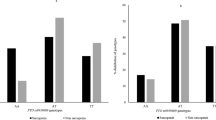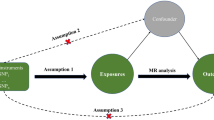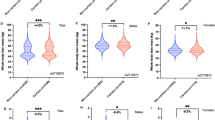Abstract
Polymorphisms in the vitamin D receptor (VDR) gene are some of the most studied in relation to skeletal muscle traits and significant associations have been observed by multiple groups. One such paper by our group provided the first evidence of a genetic association with sarcopenia in men, but that finding has yet to be replicated in an independent cohort. In the present study, we examined multiple VDR polymorphisms in relation to skeletal muscle traits and sarcopenia in 864 men and women across the adult age span. In addition to VDR genotypes and haplotypes, measurements of skeletal muscle strength and fat-free mass (FFM) were determined in all subjects and a measure of sarcopenia was calculated. We observed significant associations between Fok1 and Bsm1 genotypes and skeletal muscle strength in men and women, though these associations were modest and no significant associations were observed for these polymorphisms and muscle mass traits nor for Bsm1–Taq1 haplotype with muscle strength. Fok1 FF genotype was associated with an increased the risk of sarcopenia in older women compared to f-allele carriers (1.3-fold higher risk). These results support previous findings that VDR genetic variation appears to impact skeletal muscle strength and risk for sarcopenia but the influence is modest.
Similar content being viewed by others
References
Janssen I, Heymsfield SB, Ross R (2002) Low relative skeletal muscle mass (sarcopenia) in older persons is associated with functional impairment and physical disability. J Am Geriatr Soc 50:889–896
Lauretani F, Russo CR, Bandinelli S et al (2003) Age-associated changes in skeletal muscles and their effect on mobility: an operational diagnosis of sarcopenia. J ApplPhysiol 95:1851–1860
Melton LJ, Khosla S, Crowson CS et al (2000) Epidemiology of sarcopenia. J Am Geriatr Soc 48:625–630
Tanko LB, Movsesyan L, Mouritzen U et al (2002) Appendicular lean tissue mass and the prevalence of sarcopenia among healthy women. Metabolism 51:69–74
Sowers MR, Crutchfild M, Richards K et al (2005) Sarcopenia is related to physical functioning and leg strength in middle-aged women. J Gerontol Biol Sci 60A:486–490
Arden NK, Spector TD (1997) Genetic influences on muscle strength, lean body mass, and bone mineral density: a twin study. J Bone Mineral Res 12:2076–2081
Reed T, Fabsitz RR, Selby JV et al (1991) Genetic influences and grip strength norms in the NHLBI twin study males aged 59-69. Annals Hum Biol 18:425–432
Seeman E, Hopper JL, Young NR et al (1996) Do genetic factors explain associations between muscle strength, lean mass, and bone density? A twin study. Am J Physiol 270:E320–E327
Thomis MAI, Beunen GP, Van Leemputte M et al (1998) Inheritance of static and dynamic arm strength and some of its determinants. Acta Physiol Scand 163:59–71
Tan LJ, Liu SL, Lei SF et al (2012) Molecular genetic studies of gene identification for sarcopenia. Hum Genet 131(1):1–31
Di Renzo L, Gratteri S, Sarlo F, Cabibbo A, Colica C, De Lorenzo A (2014) Individually tailored screening of susceptibility to sarcopenia using p53 codon 72 polymorphism, phenotypes, and conventional risk factors. Dis Markers
Di Renzo L, Sarlo F, Petramala L et al (2013) Association between -308 G/A TNF-α polymorphism and appendicular skeletal muscle mass index as a marker of sarcopenia in normal weight obese syndrome. Dis Markers 35(6):615–623
Roth SM, Zmuda JM, Cauley JA et al (2004) Vitamin D receptor genotype is associated with fat-free mass and sarcopenia in elderly men. J Gerontol Biol Sci 59A:10–15
Geusens P, Vandevyver C, VanHoof J et al (1997) Quadriceps and grip strength are related to vitamin D receptor genotype in elderly nonobese women. J Bone Mineral Res 12:2082–2088
Ceglia L (2008) Vitamin D and skeletal muscle tissue and function. Mol Aspects Med 29:407–414
Montero-Odasso M, Duque G (2005) Vitamin D in the aging musculoskeletal system: an authentic strength preserving hormone. Mol Aspects Med 26:203–219
Bischoff-Ferrari HA, Borchers M, Gudat F et al (2004) Vitamin D receptor expression in human muscle tissue decreases with age. J Bone Miner Res 19:265–269
Visser M, Deeg DJ, Lips P, Amsterdam LAS (2003) Low vitamin D and high parathyroid hormone levels as determinants of loss of muscle strength and muscle mass (sarcopenia): the Longitudinal Aging Study Amsterdam. J Clin Endocrinol Metab 88:5766–5772
Arai H, Myiyamoto K, Taketani Y et al (1997) A vitamin D receptor gene polymorphism in the translation initiation codon: effect on protein activity and relation to bone mineral density in Japanese women. J Bone Min Res 12:915–921
Jurutka PW, Remus LS, Whitfield GK et al (2000) The polymorphic N terminus in human vitamin D receptor isoforms influences transcriptional activity by modulating interaction with transcription factor IIB. Mol Endocrinol 14:401–420
Uitterlinden AG, Fang Y, van Meurs JB et al (2004) Genetics and biology of vitamin D receptor polymorphisms. Gene 338:143–156
Windelinckx A, De Mars G, Beunen G et al (2007) Polymorphisms in the vitamin D receptor gene are associated with muscle strength in men and women. Osteoporos Int 18:1235–1242
Iki M, Saito Y, Dohi Y et al (2002) Greater trunk muscle torque reduces postmenopausal bone loss at the spine independently of age, body size, and vitamin D receptor genotype in Japanese women. CalcifTissue Int 71:300–307
Moreno Lima R, Silva de Abreu B, Gentil P et al (2007) Lack of association between vitamin D receptor genotypes and haplotypes with fat-free mass in postmenopausal Brazilian women. J Gerontol A Biol Sci Med Sci 62: 966–972
Suarez F, Zeghoud F, Rossignol C et al (1997) Association between vitamin D receptor gene polymorphism and sex-dependent growth during the first 2 years of life. J Clin Endocrinol Metab 82:2966–2970
Hopkinson NS, Li KW, Kehoe A et al (2008) Vitamin D receptor genotypes influence quadriceps strength in chronic obstructive pulmonary disease. Am J Clin Nutr 87:385–390
Bahat G, Saka B, Erten N et al (2010) BsmI polymorphism in the vitamin D receptor gene is associated with leg extensor muscle strength in elderly men. Aging Clin Exp Res 22:198–205
Barr R, Macdonald H, Stewart A et al (2010) Association between vitamin D receptor gene polymorphisms, falls, balance and muscle power: results from two independent studies (APOSS and OPUS). Osteoporos Int 21:457–466
Onder G, Capoluongo E, Danese P et al (2008) Vitamin D receptor polymorphisms and falls among older adults living in the community: results from the ilSIRENTE study. J Bone Miner Res 23:1031–1036
Shock NW, Gruelich RC, Andres RA, et al (1984) Normal human aging. The Baltimore longitudinal study of aging. Washington, D.C.: U.S. Government Printing Office
Lindle RS, Metter EJ, Lynch NA et al (1997) Age and gender comparisons of muscle strength in 654 women and men aged 20-93 yr. J Appl Physiol 83:1581–1587
Gallagher D, Visser M, De Meersman RE et al (1997) Appendicular skeletal muscle mass: effects of age, gender, and ethnicity. J Appl Physiol 83:229–239
Wang Z, Visser M, Ma RN et al (1996) Skeletal muscle mass: evaluation of neutron activation and dual-energy X-ray absorptiometry methods. J Appl Physiol 80:824–831
Lynch NA, Metter EJ, Lindle RS et al (1999) Muscle quality. I. Age-associated differences between arm and leg muscle groups. J Appl Physiol 86: 188–194
Zajickova K, Krepelova A, Zofkova I (2003) A single nucleotide polymorphism under the reverse primer binding site may lead to BsmI mis-genotyping in the vitamin D receptor gene. J Bone Min Res 18:1754–1757
Stephens M, Smith NJ, Donnelly P (2001) A new statistical method for haplotype reconstruction from population data. Am J Hum Genet 68:978–989
Stephens M, Donnelly P (2003) A comparison of Bayesian methods for haplotype reconstruction from population genotype data. Am J Hum Genet 73:1162–1169
Baumgartner RN, Koehler KM, Gallagher D et al (1998) Epidemiology of sarcopenia among the elderly in New Mexico. Am J Epidemiol 147:755–763
Janssen HCJP, Samson MM, Verhaar HJJ (2002) Vitamin D deficiency, muscle function, and falls in elderly people. Am J Clin Nutr 75:611–615
Grundberg E, Brandstrom H, Ribom EL et al (2004) Genetic variation in the human vitamin D receptor is associated with muscle strength, fat mass and body weight in Swedish women. Eur J Endocrinol 150:323–328
Wang P, Ma LH, Wang HY et al (2006) Association between polymorphisms of vitamin D receptor gene ApaI, BsmI and TaqI and muscular strength in young Chinese women. Int J Sports Med 27:182–186
Van Pottelbergh I, Goemaere S, De Bacquer D et al (2002) Vitamin D receptor gene allelic variants, bone density, and bone turnover in community-dwelling men. Bone 31:631–637
Li H, Stampfer MJ, Hollis JB et al (2007) A prospective study of plasma vitamin D metabolites, vitamin D receptor polymorphisms, and prostate cancer. Plos Med 4:e103
Ma J, Stampfer MJ, Gann PH et al (1998) Vitamin D receptor polymorphisms, circulating vitamin D metabolites, and risk of prostate cancer in United States physicians. Cancer Epidemiol Biomarkers Prev 7:385–390
Khoury MJ, Little J, Gwinn M et al (2007) On the synthesis and interpretation of consistent but weak gene-disease associations in the era of genome-wide association studies. Int J Epidemiol 36:439–445
Acknowledgments
We thank the volunteers who made this study possible.
Funding
The BLSA research was conducted as a component of the Intramural Research Program of the National Institute on Aging. This work was further sponsored by grants AG021500 and AG022791 from the National Institutes of Health. A. Ludlow was supported by an NIH pre-doctoral training grant AG000268.
Conflict of interest
The authors report no conflicts of interest regarding this manuscript.
Ethical approval
All procedures performed in studies involving human participants were in accordance with the ethical standards of the institutional and/or national research committee and with the 1964 Helsinki declaration and its later amendments or comparable ethical standards.
Informed consent
Informed consent was obtained from all individual participants included in the study.
Author information
Authors and Affiliations
Corresponding author
Rights and permissions
About this article
Cite this article
Walsh, S., Ludlow, A.T., Metter, E.J. et al. Replication study of the vitamin D receptor (VDR) genotype association with skeletal muscle traits and sarcopenia. Aging Clin Exp Res 28, 435–442 (2016). https://doi.org/10.1007/s40520-015-0447-8
Received:
Accepted:
Published:
Issue Date:
DOI: https://doi.org/10.1007/s40520-015-0447-8




